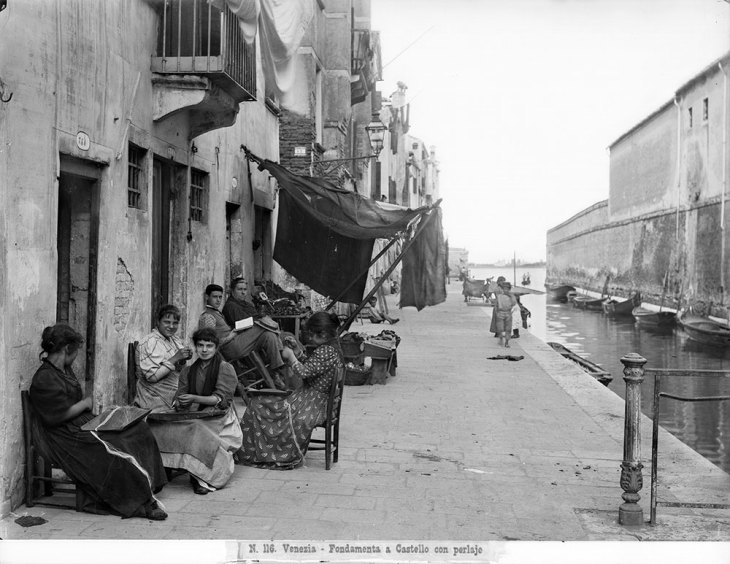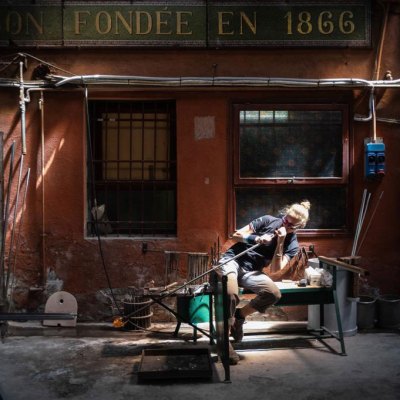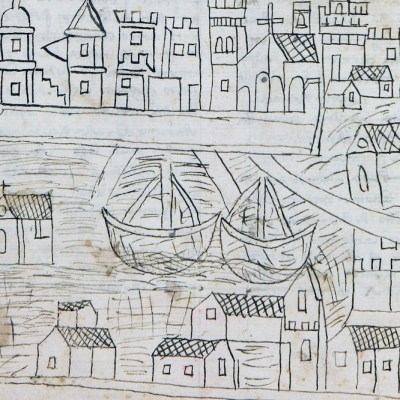Strolling through Venice in the 1800s, a visitor would encounter a recurring sight: groups of women sitting on chairs in the shade, rhythmically threading brightly coloured beads on to long, thin needles. From before dawn till late at night, these workers – from girls aged just eight or nine to the elderly – would engage in this repetitive, poorly paid work, alleviating boredom by chatting and singing folk songs. These women were the impiraresse, the bead-stringers of Venice.
Although stringing glass beads was the most common job for Venetian women up until the early 1900s, a subsequent decline in the demand for strings of beads and the boom in industrially produced imitations mean the impiraresse can no longer be seen performing their painstaking craft in the streets of the canal city. Marisa Convento is one of a small number of bead-stringers still practising the art of the impiraresse in Venice. When we speak on the phone in February (her workshop is currently shut due to Covid restrictions), she is keen to emphasise the historical importance of this craft, which is central to her efforts to preserve it.
Venetian glass beads were a precious commodity used for centuries for trade or payment. As far back as the 16th century, beads were carried by merchants and missionaries all over the world to buy land from or barter with indigenous people. The tiniest of the Venetian beads, the perline di conteria vitrea (seed beads), posed a particular transportation predicament. As Convento explains, ‘If I let a box of two or three kilos of seed beads drop, the tiny beads would scatter everywhere and we would never pick them up again.’ The craft of the impiraresse, therefore, was born as a way to facilitate the transportation of these minute beads.
Courtesy Servizio Produzioni Culturali e Rapporti con le Università, Comune di Venezia

The impiraressa’s task was to thread beads on to long needles, which contained a cotton string inside. The women would sit with a large wooden tray, or sessola, on their laps filled with several kilos of tiny beads that had been produced on the glass-making island of Murano. With needles held between their fingers and spread out like a fan, they would deftly scoop up the beads from the tray. ‘The most skilled, they say, could hold up to 50 or 60 needles in their hand,’ says Convento. ‘There are urban legends that talk of impiraresse so proficient they could hold even 80 at a time, though I’ve never seen them.’
Moving the needles forwards and backwards, the impiraresse would create threads of beads that would be tied together in a bunch with a set number of strings. ‘The bunches created a unit of measurement so that merchants and explorers using the beads for trade with natives knew what quantity of beads they were carrying,’ Convento explains.
The impiraresse could work for as many as 14 hours a day to thread the boxes of beads brought to them by the mistra, an intermediary between the bead-stringers and the glass factories. The mistra is described quite poetically in an account of the impiraresse from 1893. As author Irene Ninni writes, ‘An interesting and strange sight for anyone observing Venice through an artist’s eye, and even more for foreigners, is that of a sandoletto on a canal carrying a worker woman, with a naturally majestic bearing, surrounded by cases and boxes full of beads of every shape and colour, shining in the sun like gems. She could be mistaken for a queen.’
The bead-stringers are also captured in the art of John Singer Sargent, who depicts them sitting leisurely in a sunlit street, a scene of contentment. However, despite these romantic depictions, the work was laborious and badly paid. ‘A day’s work could be enough to buy a kilo of bread. It was a very poor life,’ says Convento. ‘However, it could be the difference between having nothing and having something.’
The Bead-stringers of Venice (1880–82), John Singer Sargent. Photo: © National Gallery of Ireland

Andrea Rossi, a fisherman from Burano, writes of his grandmother’s work as an impiraressa in his memoir, Ragionar come un pesce (2020). Her salary, though a pittance, was an essential addition to the family’s income when fishing was scarce. Rossi remembers when, as a child, he would play with the little beads, letting them run through his fingers. ‘I didn’t know at the time that this work was essential for my grandmother to round out the salary earned by my grandfather who, as a poor fisherman, sought to bring home, with immense effort, enough to live with dignity,’ Rossi writes.
The salary of the bead-stringers was so low, in fact, that in 1904 the impiraresse became some of the first women in Italy to go on strike, demanding greater rights and respect. By this point there had begun a change in the type of work performed by the impiraresse. The demand for bunches of beads prepared for transportation reduced, the impiraresse identified an opportunity to make their craft more creative. They began to invent flowers, bags, necklaces and other decorative items with the seed beads by threading them on to metal strings that could be shaped. The fashions of the 1920s and ’30s helped boost the popularity of clothing and jewellery adorned with beads.
By the 1980s, however, even the creative aspect of the art of the impiraressa was in danger. The factories on Murano producing the tiny seed beads had closed, while industrial production in other countries around the world was increasing. ‘Already in the early ’90s I remember lots of souvenir shops in Venice selling mass-produced beads and jewellery,’ Convento says.
Enamoured with Venice’s glass beads and determined to protect them, Convento began to collect antique beads and make use of them. ‘I started to get informed, to look around, to spy and after a while, I began to learn some techniques. I found original needles that the impiraresse used in the 1800s and I learnt how to thread the beads and make objects with them alla Veneziana.’
Marisa Convento in her workshop in Venice. Photo: Silvia Benedet

She emphasises that the only beads she will use are those produced in Venice. ‘They are particular for their irregular texture. They are full of life with incredible colours.’ Despite production halting in the late 1980s, so many of these seed beads had been produced that there are warehouses on Murano full of them, as well as wholesalers abroad that bought from Murano when the glass factories were closing. As such, Convento’s necklaces, flowers and other objects use beads that are at least 30 or 40 years old, and the most prized are made with antique beads that could date from the 19th century. Her trademark creations are beads worked into the form of coral and made into necklaces. ‘They represent Venice, the queen of the seas,’ Convento says.
As part of her desire to protect the art of the impiraresse, Convento was instrumental in a seven-year drive, together with a community in France, to achieve Unesco heritage status for the art of glass beads. She is a member of the Italian committee (Comitato per la Salvaguardia dell’Arte delle Perle di Vetro veneziane) founded in 2013, and comprising historians, anthropologists and glass workers, that put forward the Unesco nomination along with its French counterpart. At the end of December last year, the Art of Glass Beads was awarded Intangible Cultural Heritage status. Convento remembers, ‘When we heard we jumped for joy – I still tremble now thinking about it!’
The designation covers the various types of production and use of glass beads in Venice and in France, which include the work of the impiraresse. For Convento, the heritage status bolsters her ultimate goal: to safeguard the art of the impiraresse and glass beads. ‘The path begins now, Unesco heritage lets our voices be heard more loudly, we are the bead people of Venice and we have the support of this international body.’
Convento hopes to add to the roster of events already celebrating bead-stringing, which include an exhibition about the impiraresse during Venice Glass Week last September and a Festa delle Impiraresse organised by another Venetian bead-stringer, Luisa Conventi. Despite the current restrictions, there are already plans for a new Festival of Glass Beads that incorporates participation from other countries and an annual prize that will be awarded to a person whose efforts in the preservation and transmission of the art of glass beads have been particularly commendable. ‘Unesco does not hold funerals,’ Convento says. ‘The most important thing is to keep this art alive and pass it on intact to the next generations.’


